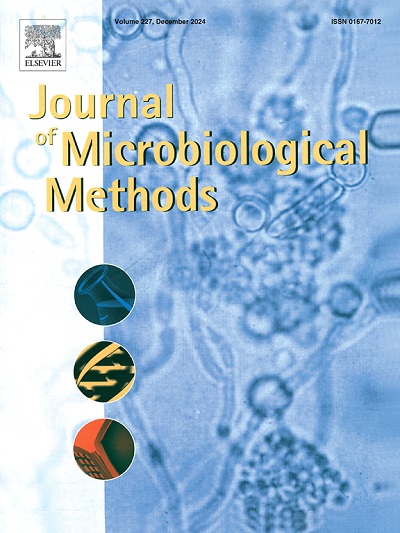Carcinoscorpius and Tachypleus lysates assay for detecting endotoxin in milk and groundwater: Toward reducing reliance on Limulus amebocyte lysate
IF 1.9
4区 生物学
Q4 BIOCHEMICAL RESEARCH METHODS
引用次数: 0
Abstract
As one of the emerging pollutants, the presence of endotoxins became an increasingly urgent issue due to their impact on human health when found in drinking water and groundwater. A simple and rapid assay for assessing bacterial biomass in these water samples was essential, particularly in situations where access to laboratory facilities was limited. The bacterial endotoxin test (BET) using the Limulus amebocyte lysate (LAL) test was established as an effective method. However, the application of BET employing Carcinoscorpius or Tachypleus Amebocyte Lysate (CAL/TAL), derived from Carcinoscorpius rotundicauda and Tachypleus gigas, remained rarely performed. This study aimed to explore the CAL and TAL potential for detecting bacterial endotoxins in milk and groundwater. In this assay, 94 blood samples of horseshoe crabs collected from the Banyuasin Waters of South Sumatra (79 samples of C. rotundicauda and 15 samples of T. gigas) were used. The assay was carried out using the gel-clot method. The results revealed that the CAL and TAL were able to detect small concentrations of endotoxin (up to a concentration of 0.0156 EU/mL) in raw milk, pasteurized milk, well water, and L1 HPV 52 protein based on the gel-clot test. Both CAL and TAL could be a potential substitute for the LAL assay, especially for detecting bacterial biomass in milk and groundwater. Furthermore, these findings were essential as initial scientific information for developing the CAL/TAL tests toward the development of recombinant Factor C (rFC).
检测牛奶和地下水中内毒素的鲎试剂和鲎试剂:减少对鲎试剂的依赖
内毒素作为一种新兴的污染物,在饮用水和地下水中发现对人体健康的影响已成为一个日益紧迫的问题。对这些水样中的细菌生物量进行简单而快速的测定是必不可少的,特别是在使用实验室设施有限的情况下。建立了用鲎试剂(LAL)法进行细菌内毒素检查的有效方法。然而,利用从圆尾癌(Carcinoscorpius rotundicauda)和巨尾癌(Tachypleus gigas)中提取的巨尾癌(tacypleus Amebocyte Lysate, CAL/TAL)进行BET的应用仍然很少。本研究旨在探讨CAL和TAL法检测牛奶和地下水中细菌内毒素的潜力。本实验使用了从南苏门答腊岛Banyuasin水域采集的94份马蹄蟹血样(79份为圆形马蹄蟹,15份为gigas马蹄蟹)。实验采用凝胶凝块法。结果显示,CAL和TAL能够在原料奶、巴氏杀菌奶、井水和L1 HPV 52蛋白中检测到小浓度的内毒素(最高浓度为0.0156 EU/mL)。CAL和TAL都有可能成为LAL法的潜在替代品,特别是在检测牛奶和地下水中的细菌生物量方面。此外,这些发现对于开发重组因子C (rFC)的CAL/TAL测试是必不可少的初始科学信息。
本文章由计算机程序翻译,如有差异,请以英文原文为准。
求助全文
约1分钟内获得全文
求助全文
来源期刊

Journal of microbiological methods
生物-生化研究方法
CiteScore
4.30
自引率
4.50%
发文量
151
审稿时长
29 days
期刊介绍:
The Journal of Microbiological Methods publishes scholarly and original articles, notes and review articles. These articles must include novel and/or state-of-the-art methods, or significant improvements to existing methods. Novel and innovative applications of current methods that are validated and useful will also be published. JMM strives for scholarship, innovation and excellence. This demands scientific rigour, the best available methods and technologies, correctly replicated experiments/tests, the inclusion of proper controls, calibrations, and the correct statistical analysis. The presentation of the data must support the interpretation of the method/approach.
All aspects of microbiology are covered, except virology. These include agricultural microbiology, applied and environmental microbiology, bioassays, bioinformatics, biotechnology, biochemical microbiology, clinical microbiology, diagnostics, food monitoring and quality control microbiology, microbial genetics and genomics, geomicrobiology, microbiome methods regardless of habitat, high through-put sequencing methods and analysis, microbial pathogenesis and host responses, metabolomics, metagenomics, metaproteomics, microbial ecology and diversity, microbial physiology, microbial ultra-structure, microscopic and imaging methods, molecular microbiology, mycology, novel mathematical microbiology and modelling, parasitology, plant-microbe interactions, protein markers/profiles, proteomics, pyrosequencing, public health microbiology, radioisotopes applied to microbiology, robotics applied to microbiological methods,rumen microbiology, microbiological methods for space missions and extreme environments, sampling methods and samplers, soil and sediment microbiology, transcriptomics, veterinary microbiology, sero-diagnostics and typing/identification.
 求助内容:
求助内容: 应助结果提醒方式:
应助结果提醒方式:


